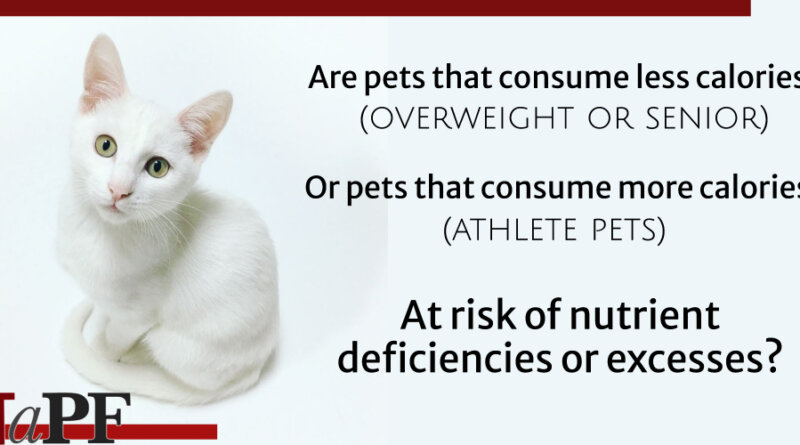Complete and Un-Balanced? – Truth about Pet Food
Several years ago we took a problem, based on speculation, to AAFCO’s Pet Food Committee Chair. AAFCO dismissed our concern, actually refusing to even discuss the problem we suspected was happening. Today we have (some) evidence the problem is real. We have provided the FDA our evidence (in a meeting very recently), and we need your help to determine how vast the problem is.
The problem…
Complete and Balanced Pet Foods are ONLY ‘balanced’ if the cat or dog is eating the correct amount of food. Pets that consume less calories (overweight or senior) or pets that consume more calories (athlete pets) are at risk of experiencing nutrient deficiencies or excesses.
The background…
Per the FDA, Complete and Balanced pet foods are “intended to be fed as a pet’s sole diet.” Complete = all the required nutrients, Balanced = required nutrients at appropriate levels (no excesses or deficiencies).
Complete is achieved when the manufacturer includes all the required nutrients – such as protein, vitamins and minerals.
‘Balanced’ is achieved when the food is required to contain a set level of nutrients (protein, vitamins and minerals) per a set amount of calories. A ten pound dog consumes an estimated amount of calories, a fifty pound dog consumes a higher estimated amount of calories – and when both dogs eat the predetermined amount of calories, they receive a balanced diet.
But…what happens when the pet eats less than the estimated calories? Or more than the estimated calories?
The ‘estimated calories’ IS the problem.
In the US, no matter the style of pet food – all pet foods labeled as Complete and Balanced are required to either meet AAFCO Nutrient Profiles or pass an AAFCO Feeding Trial. Most US pet foods are formulated to meet AAFCO Nutrient Profiles.
The National Research Council has established daily calorie (kcal) requirements for cats and dogs, based on their activity levels.

Unfortunately, AAFCO’s estimated calorie consumption for pets is the National Research Council’s Active Pets daily kcal levels.

In other words, AAFCO’s Nutrient Profiles assume all ten pound cats consume 280 kcals a day – all 30 pound dogs consume 922 kcals a day, regardless to their actual caloric needs based on activity level.
Again – what happens when the pet consumes less than the estimated calories? Or more than the estimated calories?
A ten pound active dog consuming 404 kcals per day and a ten pound inactive dog consuming 296 kcals per day – both need the same level of nutrients in their food (same percentage of protein, same percentage of vitamins and minerals for their size).

In Europe, pet foods are formulated with activity level of the pet in mind. Note in the brief example below, European Pet Food Nutritional Profiles for Inactive Cats and Dogs require a higher minimum percentage of nutrients per 1,000 kcal than the AAFCO Nutrient Profiles. European pet foods take into consideration that inactive pets consume less calories but still need the proper level of nutrients from their pet food (a more nutrient dense pet food).

But in the US, AAFCO has a one-size-fits-all type system, no consideration of calorie requirements of inactive or active/athlete pets. Our limited investigation is indicating (potentially millions of) pets could be suffering from nutrient deficiencies or excesses. For example:

Of significance: This problem is NOT the fault of any pet food manufacturer. All manufacturers are required by regulation to meet AAFCO Nutrient Profiles (or perform an AAFCO Feeding Trial). The fault of this problem is AAFCO, and secondarily the FDA. Your concern (and anger) should be directed at AAFCO and FDA, not your pet food manufacturer.
We Need Your Help!
Pet foods are formulated in different ways, even though they are all required to meet the same AAFCO Nutrient Profiles. Some pet foods are formulated to be just above (example 10% above) AAFCO Nutrient Profile minimum requirements for nutrients (protein, vitamins and minerals). Other pet foods are formulated to be well above (example 20%) AAFCO Nutrient Profile minimum requirements for nutrients. And other foods are formulated well above minimums in vitamins and minerals while barely above in protein and fat. Or some foods could be the opposite, well above minimum protein and fat and barely above minimums for vitamins and minerals.
The problem for pet owners (and us working to determine how pervasive this problem is) – is that most pet foods do not provide a full nutritional analysis of their pet food. Pet owners are not told how the food was formulated (minimum nutrients, moderate nutrients, or high nutrients) and in turn pet owners are not told if their pet is experiencing nutrient deficiencies or excess due to eating less or more calories per day.
We (Dr. Karen Becker, pet food formulator Steve Brown, and myself) found a couple of nutritional analysis data sheets provided on manufacturer’s websites. The presentation we gave to FDA used these actual nutritional analysis data to example to FDA how a pet consuming less or more calories can (is) causing nutrient deficiencies or excesses.
But we need more complete nutritional analysis information from pet food manufacturers.
The FDA told us they would need to verify the issues we presented (understandable), and asked us to give them 30 days for this verification. However, we are not waiting.
Dr. Karen Becker, Dr. Barbara Royal, Dr. Judy Morgan, Dr. Laurie Coger, Dr. Cathy Alinovi, Dr. Susan Recker, Steve Brown and a few others (including myself) are all volunteering their time and efforts to not only fix the problem – but to give pet owners a better understanding of how to properly feed their pet (preventing deficiencies and excesses) while we wait for FDA to take action.
We fully intend to have a complete understanding of the problem by the time FDA’s 30 days are up. So…
We desperately need every pet owner to help us. Please call or email your pet food manufacturer and ask them to provide you a full nutritional analysis of the food you provide your pet. Dr. Barbara Royal has volunteered to collect the data and assist Steve Brown with the analysis. Please email your pet food nutritional analysis to: datacollector@animaldietformulator.com.
Ask your manufacturer: Will you email me a full nutritional analysis of XYZ Pet Food (provide your manufacturer with the full product name)?
Please know – we are NOT judging any pet food manufacturer. Their formulas are legally required to meet AAFCO Nutrient Profiles. We only want to collect a large number of nutritional analysis to example (for FDA) the feeding more/feeding less nutrient problem.
And please know we cannot give you a personal analysis of your pet’s food based on the calories they are consuming. We are taking on what we believe could be a massive problem for pets. While we all understand your concern for your pet, we are working as quickly as we can and we hope to have options for pet owners in the near future (while we wait for FDA). We need the data (nutritional analysis) first. Call or email your manufacturer and ask for a full nutritional analysis of your pet’s food. Email it to datacollector@animaldietformulator.com.
My thanks to everyone in advance. As more is learned, it will be shared.
Wishing you and your pet(s) the best,
Susan Thixton
Pet Food Safety Advocate
Author Buyer Beware, Co-Author Dinner PAWsible
TruthaboutPetFood.com
Association for Truth in Pet Food

Become a member of our pet food consumer Association. Association for Truth in Pet Food is a a stakeholder organization representing the voice of pet food consumers at AAFCO and with FDA. Your membership helps representatives attend meetings and voice consumer concerns with regulatory authorities. Click Here to learn more.
What’s in Your Pet’s Food?
Is your dog or cat eating risk ingredients? Chinese imports? Petsumer Report tells the ‘rest of the story’ on over 5,000 cat foods, dog foods, and pet treats. 30 Day Satisfaction Guarantee. Click Here to preview Petsumer Report. www.PetsumerReport.com
Find Healthy Pet Foods in Your Area Click Here

The 2023 List
Susan’s List of trusted pet foods. Click Here to learn more.



